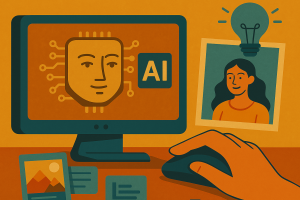عنوان: تأثیر هوش مصنوعی بر گرافیک و تبلیغات
نویسنده: محمود بیات
مقدمه
با پیشرفت روزافزون هوش مصنوعی در سالهای اخیر، مرز میان فناوری و خلاقیت بیش از پیش کمرنگ شده است. در این میان، دو حوزهی طراحی گرافیک و تبلیغات به سرعت تحت تأثیر قرار گرفتهاند و ابزارها و روشهای سنتی را متحول کردهاند.
۱. تحول در فرآیند طراحی گرافیک
-
تولید خودکار تصاویر: با ظهور ابزارهایی مانند DALL·E و Midjourney، طراحان میتوانند تنها با وارد کردن یک “پرامپت” (توضیح متنی) طیف وسیعی از تصاویر و پوسترهای گرافیکی را در چند ثانیه تولید کنند.
-
بهینهسازی ترکیببندی و رنگ: الگوریتمهای یادگیری ماشین میتوانند بر اساس قواعد زیباییشناسی، رنگها، فونتها و چینش المانها را پیشنهاد دهند و فرایند آزمونوخطا را کوتاه کنند.
-
افزایش بهرهوری: ابزارهای AI اجازه میدهند طراحان به جای صرف زمان طولانی بر جزئیات فنی، تمرکز خود را بر خلاقیت و ایدهپردازی بگذارند.
۲. هوش مصنوعی در تبلیغات هدفمند
-
شخصیسازی پیام: با تحلیل رفتار کاربران در شبکههای اجتماعی و وبسایتها، AI میتواند پیام تبلیغاتی و طراحی گرافیک بنرها را متناسب با سن، جنسیت و علاقهمندی هر فرد تنظیم کند.
-
تولید انبوه نسخهها: یک کمپین تبلیغاتی میتواند صدها نسخهی گرافیکی متفاوت داشته باشد که هر کدام برای یک دستهی مخاطب خاص بهینه شده است؛ بدون نیاز به طراحی دستی تمام نسخهها.
-
تحلیل اثربخشی: ابزارهای هوش مصنوعی در لحظه نرخ کلیک (CTR) و تعامل کاربران را آنالیز میکنند و نسخههای مؤثرتر را شناسایی مینمایند.
۳. همکاری خلاقانه انسان و ماشین
-
نقش طراح: ایدهپردازی، مفهومسازی و تصمیمگیری در مورد پیام کلی همچنان بر عهدهی طراح است.
-
نقش AI: اجرای سریع، ارائهی گزینههای متنوع و انجام اصلاحات آنی بر اساس بازخورد.
-
نتیجه: ترکیب توان خلاقیتی انسان با سرعت و دقت ماشین، به خلق آثار نوآورانهتر و اثربخشتر منجر میشود.
۴. چالشها و ملاحظات
-
یکنواختی در سبک: به کارگیری مشترک مدلهای یکسان میتواند به شباهت بیش از حد آثار منجر شود.
-
حقوق مالکیت معنوی: قوانین موجود هنوز پاسخگوی خلق محتوا توسط AI نیستند و باید چارچوبهای جدیدی تعریف شود.
-
حریم خصوصی: جمعآوری و تحلیل حجم بالای دادههای کاربران، نیازمند رعایت دقیق مقررات حفاظت از اطلاعات است.
-
حفظ خلاقیت انسانی: ابزارها نباید مانعی برای تفکر خلاق باشند؛ بلکه باید کمکی باشند برای گسترش ایدهها.
۵. چشمانداز آینده
ترکیب AI با فناوریهایی مانند واقعیت افزوده (AR)، واقعیت مجازی (VR) و طراحی تعاملی میتواند تبلیغات را به یک تجربهی فراگیر و شخصیسازیشده تبدیل کند. طراحانی که این ابزارها را بیاموزند و در فرایندهای خود ادغام کنند، در بازار رقابتی آینده برنده خواهند بود.

Title: The Impact of Artificial Intelligence on Graphic Art and Advertising
Author: Mahmoud Bayat
Introduction
The rapid advancement of artificial intelligence (AI) has blurred the lines between technology and creativity. Graphic design and advertising, once reliant on manual skill and lengthy processes, are now experiencing a paradigm shift thanks to AI-powered tools and techniques.
1. Transformation in Graphic Design Workflow
-
Automated Image Generation: Platforms such as DALL·E and Midjourney enable designers to generate a wide range of visuals and poster concepts in seconds by simply inputting a textual prompt.
-
Intelligent Layout and Color Selection: Machine learning algorithms suggest optimal color palettes, typography, and composition rules based on aesthetic principles, reducing trial-and-error cycles.
-
Enhanced Productivity: Designers can shift their focus from technical execution to ideation and creativity, as AI handles repetitive tasks.
2. AI in Targeted Advertising
-
Personalized Messaging: By analyzing user behavior across social media and websites, AI tailors ad copy and graphic content to match an individual’s age, gender, and interests.
-
Mass Customization: A single ad campaign can produce hundreds of unique graphic variants, each optimized for a specific audience segment without manual redesign.
-
Real-Time Performance Analysis: AI-driven analytics monitor click-through rates and engagement metrics, identifying the most effective versions on the fly.
3. Human–Machine Creative Collaboration
-
Designer’s Role: Conceptualizing ideas, defining the creative direction, and making strategic decisions remain firmly in human hands.
-
AI’s Role: Rapid execution, diverse option generation, and instant refinement based on feedback.
-
Outcome: The synergy of human creativity and AI efficiency leads to more innovative and impactful designs.
4. Challenges and Considerations
-
Stylistic Homogenization: Widespread use of similar AI models can result in visually uniform outputs across designers.
-
Intellectual Property Rights: Legal frameworks need updating to clarify ownership of AI-generated content.
-
Privacy Concerns: Collecting and processing vast amounts of user data necessitate strict adherence to privacy regulations.
-
Preserving Human Creativity: AI should augment—not replace—the designer’s creative thinking.
5. Future Outlook
Integrating AI with augmented reality (AR), virtual reality (VR), and interactive design will transform advertising into an immersive, highly personalized experience. Designers who embrace and master these AI-driven tools will thrive in the evolving digital landscape.


